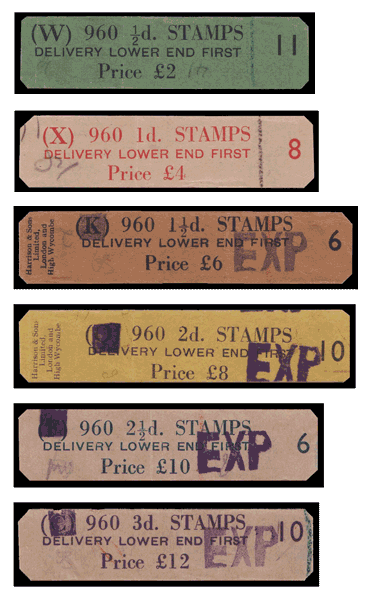
Post Office counter machines were designed to speed up the sale of stamps over the counter.
An experiment with a three-tier counter machine began at Mount Pleasant Branch Office in 1947. Each tier had two emitters enabling the machine to dispense six different stamp values: ½d to 3d. Only ½d and 1d stamps were available in rolls for vending machines at the time, so special experimental rolls were made up with 1½d to 3d stamps. These rolls were overprinted “EXP”, short for “experimental” and not to be confused with the 1952 (EXP) rolls which were for use in exposed places.
The then current (W) and (X) rolls were used for ½d and 1d (not (D) and (B) as Langston & Corless presumed), but as there were no higher values available wound for vending machines, special rolls were made up for 1½d, 2d, 2½d, and 3d values. Leaders were used from the POKO series of rolls (KQFC) but these were not POKO rolls, they were wound facing inwards rather than outwards, and on a smaller core, so the stock letters were obliterated to avoid confusion, and a large “EXP” stamped on each leader.
The experiment ran at Mount Pleasant for about 5 years from 20 Jan 1947 to Feb/Mar 1952. At least two other offices used these machines: Romford Post Office from 12 Aug 1947 to 20 Mar 1948, and Southall Head Post Office from 13 June 1948. The latter sold 1d, 2d, 2½d, 3d, 6d, and 9d stamps.
| W | ½d | 960 | £2 | Lower End | Green/Buff | c |
| X | 1d | 960 | £4 | Lower End | Buff | c |
| EXP | 1½d | 960 | £6 | Lower End | Buff | c |
| EXP | 2d | 960 | £8 | Lower End | Yellow/Buff | 20 |
| EXP | 2½d | 960 | £10 | Lower End | Buff | c |
| EXP | 3d | 960 | £12 | Lower End | Buff | 20 |

Langston & Corless believed their set was unique, but the shape of the overprints they illustrate as “Opt. (a)” and “Opt. (b)” look different from those shown above. Perhaps there are two sets.
Next: KGVI Checklist